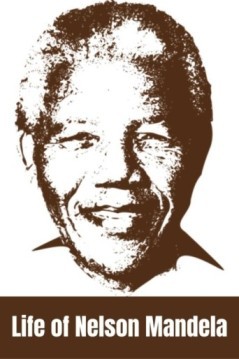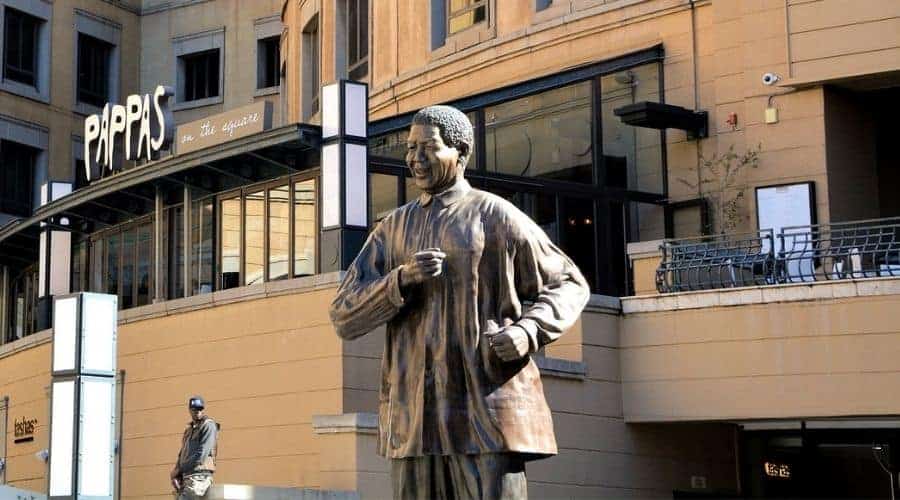Nelson Mandela is one of the most famous South African political figures. He was born in 1918, served 27 years in prison for his resistance to apartheid rule, and later became president after being elected by an overwhelming majority.
Nelson Mandela was a South African anti-apartheid revolutionary, politician, and philanthropist who served as President of South Africa from 1994 to 1999.
Mandela was a private person who often denied interviews and refused to be seen when not dressed in public view. He spoke with an African accent that had disappeared among younger Black South Africans, retaining the Bantu grammatical patterns of his native Xhosa language that were evident even in his speeches.
Mandela started every public speech with the Xhosa words “Equal umuntu, ngeqo noqu ndodana” (“A person is a person through other persons”).

Mandela was raised in the Thembu royal family of the Xhosa. Although he renounced his claim to the throne when he joined the ANC, he remained loyal to his clan, the Thembu. He lived in Mvezo for a period when he was a young boy.
Mandela’s father was Gadla Henry Mphakanyiswa Gadla Mandela (1880 – July 18, 1941), principal counsellor to the Acting King of the Thembu people, Jongintaba Dalindyebo. His father had been appointed as acting regent and heir to the throne in 1941 following the death of his grandfather, Regent Jongintaba Dalindyebo.
Mandela joined the African National Congress (ANC) in 1943 and participated in the 1946 anti-apartheid Defiance Campaign and went on to become a founding member of its Youth League.
Read: Famous Books by Robert Kiyosaki to Learn Entrepreneurship & Investing
He was arrested for seditious activities in 1956 and 1957 and subsequently sentenced to six years imprisonment. After his release from prison, Mandela worked as President of the African National.
Nelson Mandela has received more than one hundred awards over four decades, most notably the Nobel Peace Prize in 1993. He is currently a celebrated elder statesman who continues to voice his opinion on topical issues.
In South Africa he is often known as Madiba , an honorary title adopted by elders of Mandela’s clan. The title has come to be synonymous with Nelson Mandela.

Day-by-day Event of Nelson Madela’s Last Days
Mandela was hospitalized on 1 June 2013 in Pretoria and, according to Jacob Zuma “is responding to treatment.” On 28 January 2013 President Jacob Zuma announced that Mandela’s condition was critical but stable.
The next day, party officials stated that this had been due to an acute respiratory infection.
On 3 June 2013, the Presidency released a statement that said Mandela’s condition had worsened, according to reports his lungs were failing. Zuma visited him that day and called for prayers from the public.
The next day, his daughter Makaziwe indicated that he was in a “difficult time”. His wife Graça Machel spoke of her concern that he would not be able to recover.
Mandela was visited by Zuma on 11 June 2013. The South African government released a statement later that day saying Mandela’s condition had become “critical”.
The South African government refused to disclose information regarding his health while he remained in hospital. Initially, Mandela was criticized by the ANC Youth League and the SA Communist Party for this decision. An editorial in a South African newspaper stated that his condition “undermines our democratic claims”.
Mandela’s lung infection worsened, but he received treatment from December 2012 until March 2013 at a hospital in Pretoria. In late February 2013, the Presidency announced that his condition was “serious but stable”.
On 25 March 2013, Zuma visited Mandela for a second time since he entered hospital and stated afterwards that his health was improving. The next day, South Africa’s Sunday Times newspaper reported that Mandela had been taken to a Pretoria hospital where doctors were concerned about his lungs.
On 11 April 2013, Zuma visited Mandela at the hospital in Pretoria, stating afterward that his condition had become “serious”. Facing growing concerns for his health, on 21 May 2013 it was reported that Mandela had been taken to a Pretoria hospital. Zuma then visited him there and stated he was in a “serious but stable condition”.
On 4 June 2013, Mandela was visited by Zuma who said his condition was “much better” than the last time he visited. A day later, the Presidency stated that there would be no change to its previous statement that Mandela’s condition remained serious but stable. The ANC then published a tweet that read, “Reports about President #Mandela being critical are wrong. The Presidency has noted false reports & therefore these remain false.”
On 25 June 2013, it was announced that Mandela had been discharged from Milpark Hospital after three months of treatment for a recurring lung infection, and that he would receive respiratory therapy at his home in Houghton. This information was reported by City Press on the basis of an unnamed medical source. Zuma’s spokesperson stated that Mandela was in “serious but stable” condition.
On 8 July 2013, the South African Press Association reported that Mandela had returned home after being discharged from hospital earlier in the week. A senior doctor for the University of Cape Town Medical School said that he was “not aware of any other former head of state living with” the respiratory condition from which Mandela was suffering. On 10 July 2013 it was reported that Zuma had visited his home “to check on him”, although he insisted that he did not want to be seen as a “saviour”.
On 1 August 2013, Mandela was admitted to a Pretoria hospital for a scheduled overnight observation, according to the South African presidency. On 3 August 2013 Zuma reported that Mandela was in a “stable condition” and would be released from hospital within 48 hours. In a statement, it said: “The doctors have decided to keep former President Nelson Mandela in hospital for further observation. We appeal to the media and the public to respect the privacy of Madiba and his family, even as we appeal for information on his health condition.” On 5 August 2013, Zuma gave a statement saying that Mandela was doing well and closing the hospital.
On 8 September 2013, it was reported that Mandela had been admitted to 1 Military Hospital in Pretoria because he was suffering from pneumonia. Zuma visited him in hospital. On 12 September 2013 Mandela was discharged from the military hospital, after having received treatment for pneumonia, according to Zuma who gave an update on Mandela’s condition at a media briefing.
On 23 November 2013, it was reported that Mandela had his fourth bout of pneumonia and was receiving treatment in Pretoria. The following day, the South African President Jacob Zuma released a statement that “Madiba is well-respected and loved by all South Africans and the entire world. We appeal to South Africans and people around the world to pray for our beloved Madiba and his family.”
Death of Nelson Mandela
On 15 December 2013, Mandela died at home in Houghton, Johannesburg, following a long illness. He passed away shortly after 8:00 pm local time (UTC+2) surrounded by his family. The South African government announced that it would be organizing a state funeral and national day of mourning for Mandela, with the date to be announced in due course. It was later decided that he would receive a full state funeral and flags would be flown at half-mast all day on December 16, 2013.
Early Life of Nelson Mandela
Nelson Rolihlahla Mandela was a South African anti-apartheid revolutionary, statesman and philanthropist who served as President of South Africa from 1994 to 1999. He was the country’s first black head of state and the first elected in a fully representative democratic election.
Nelson Madela’s Married Life
Mandela’s first marriage was to Evelyn Ntoko Mase (1922 – September 29, 2004). They were married from 1954 to 1957. Their first son, Madiba “Thembi” Thembekile, was born in February 1955.
The couple divorced in June 1958 under the multiple strains of his adultery, love affairs with liberation movement activists Ruth Mompati and Winnie Madikizela Mandela née Madikizela (born Nomzamo Winifred Zanyiwe Madikizela on 26 July 1936), who eventually became his second wife.
Nelson Mandela married for the second time on his 80th birthday in July 1998. Graça Machel (née Simbine), widow of former Mozambican president Samora Machel, was 39 years old at the time of their marriage.
She is currently an ambassador for many causes and head of several charities founded by Mandela, such as the Nelson Mandela Children’s Fund.
Who Was Nelson Mandel’s Mother?
Mandela’s mother was Gadla Mase (1910 – 1991). She was a daughter of Mphakanyiswa, principal counsellor to Acting King Jongintaba Dalindyebo. Mandela was born in Mvezo , a small village 100 kilometres (62 miles) south-east of Umtata , on 18 July 1918.
He had three younger sisters—Makaziwe Phumia, also born in the Transkei , and the twins Nokukhanya and Nobandhla. Another sister, Baliwe Mphakanyiswa, died as an infant while Mandela was incarcerated on Robben Island.
Nelson Mandela’s name at birth was Rolihlahla Dalibhunga Mandela—all the names had a meaning in his native Xhosa. “Rolihlahla” can be translated roughly as “pulling the branch of a tree”, but more specifically, the name is derived from the word “gxala”, which means to get someone out of prison or exile, and his biological father was called Nelson.
He became known as Rolihlahla Mandela after his father, who died in 1935. Mandela later adopted the surname Machela after accidentally stumbling upon the name Nelson.
Mandela is often popularly referred to as Madiba , his clan name; this is an honorary title adopted by elders of Mandela’s clan—the Thembu people —and not his first name. However, like many Xhosa people, Mandela also had an English name, which he used in his early years in the Western Cape and during his school education; it is unknown what it was.
After beginning his primary education at Clarkebury Boarding Institute, when he was about 11 years old, Mandela attended Healdtown, a Methodist boarding college in Fort Beaufort, for three years. At the age of 15 he went to St. Peter’s Secondary School, a Catholic school at Clarkebury, where he was elected first council prefect. He completed his Junior Certificate there in two years rather than the usual three.
Nelson Mandel’s Joning of African National Congress (ANC)
Mandela joined the African National Congress (ANC) in 1943, becoming a member of its Youth League in 1944, and the following year joined its Transvaal branch. At the time the ANC was considered a conservative organization—it had avoided participating in the Congress Alliance, an alliance of anti-colonial organizations such as the ANC Youth League (ANCYL), South African Indian Congress (SAIC), Colored People’s Congress, Natal Indian Congress (NIC) — and was focused on resolving the grievances of black South Africans through nonviolence. Mandela opposed this initially, but later became more active in the ANCYL.
Movements by Nelson Mandela
During this time, Mandela met Anton Lembede, an ANC member affiliated with the Youth League who had developed a distinctive African nationalist outlook—one that proved to be a profound influence on Mandela. Under Lembede’s influence, Mandela embraced the Pan-Africanist Congress’ motto “Africa for the Africans; now!”
Appalled by a statement in a report delivered to ANC leader Anton Lembede, which stated that “the Native is not yet ready” to be part of the general populace and should thus be denied the right to vote, Mandela took his protest to the ANC leadership.
He was eventually backed by a majority of ANC leaders and was subsequently appointed as an organizer, overseeing the congress’s activities in the region around Johannesburg. Mandela later accredited Lembede for having been one of the architects of his political outlook when he stated that “it was Anton Lembede who taught me how to think and what I was thinking.”
Formation of the Umkhonto we Sizwe (MK), or “Spear of the Nation”
In 1946, a group of militant ANC members formed the Umkhonto we Sizwe (MK), or “Spear of the Nation”. Mandela became one of its founding members and rose rapidly through its ranks as its policies shifted from passive resistance towards violent uprising.
In 1949, he travelled to the first ANC national conference since its banning in 1940, held secretly at the farm of Alfred Bitini Xuma . There he was elected deputy president of the ANCYL.
He also worked as a lawyer for the firm of Witkin, Sidelsky and Eidelman, acting on behalf of mostly black clients in cases against white commercial farmers and the white-minority government.
Mandela’s political views were influenced by those of South Africa’s first black lawyer, Pixley ka Isaka Seme, who believed that Africans should be able to take control of South Africa themselves rather than being acted upon by other parties such as imperialists or capitalists.
Nelson Mandela’s fight against aparthied
Apartheid was a system of racial segregation in South Africa enforced through legislation by the National Party (NP) government. In 1948, Afrikaner nationalists won the general election and began to implement their policy of apartheid.
The NP introduced measures which led directly to the disenfranchisement of black Africans from 1951 onwards, as blacks were removed from the common voters’ roll and replaced with a separate voters’ roll for African citizens
Nelson Mandela is one of those people who changed history forever after his 27 years imprisonment that ended on February 11th 1990 when he walked out from prison with an amazing smile on his face.
He’s been called many things, including freedom fighter, revolutionary, statesman and even saint, but no one can deny that he played a key role in ending apartheid rule in South Africa.
By standing up against apartheid at great personal risk – going to jail for 27 years – Mandela fought tirelessly for democracy and justice not only during his lifetime but also after he retired from politics.
He was an African National Congress (ANC) leader who played a crucial role in the negotiations to end apartheid rule and bring equality to South Africa. Mandela is also known for his advocacy of ethnic reconciliation, which was instrumental in easing tensions after apartheid.
Nelson Mandela as a President
Nelson Mandela was a South African anti-apartheid revolutionary, politician and philanthropist who served as President of South Africa from 1994 to 1999. He was the first black head of state in South Africa.
Mandela’s political career began when he joined the African National Congress (ANC) in 1943. After his release from prison, he led the ANC through negotiations with President F.W de Klerk to abolish apartheid and establish multiracial elections in 1994, which resulted in him being elected president by a landslide victory.
As president, he promulgated a new constitution and initiated the Truth and Reconciliation Commission to investigate past human rights abuses, while also establishing policies for racial reconciliation between white people and other races within society.
In this role, Mandela became one of the most influential figures not only on issues related to race but also on those related to national security or international relations throughout much of southern Africa during his tenure as well as globally among many other communities outside South Africa where anti-apartheid movements were active at that time such as Europe or North America.
His presidency has been praised for its contribution towards dismantling apartheid through both legislation like abolishing segregated education system & land reform laws while also promoting social justice through public works programs like building houses for poor families & providing access to water & electricity across all regions of South African society regardless their color or background; these achievements made him an icon around the world due largely because they were achieved under conditions of extraordinary adversity.
Conclusion
Mandela campaigned against apartheid and became one of its most eloquent defenders; his articulation of the philosophy behind ANC ideas led to many international supporters for this anti-apartheid movement, including Americans like Harry Belafonte, Sidney Poitier, Josephine Baker, Muhammad Ali and Dick Gregory.
Books on Nelson Mandela that are worth reading include Conversations with Myself by Mr. Mandela or Long Walk To Freedom by Mr. Mandela himself, which is an autobiography about his life up until 1994 when he was released from prison after 27 years as a political prisoner under South Africa’s Apartheid regime.
Related Articles:
- Master Self-Discipline: Transform Your Life in 2025 with These Essential Strategies!
- Ebook Design for Children’s Books: Capturing Young Minds Visually
- Expanding on the Value of Professional Fashion Design Services
- Get Custom African American Character Illustrations with Any Hairstyle
- Transform Your Look with Rasaline’s Expert Hairstyle and Fashion Advice









